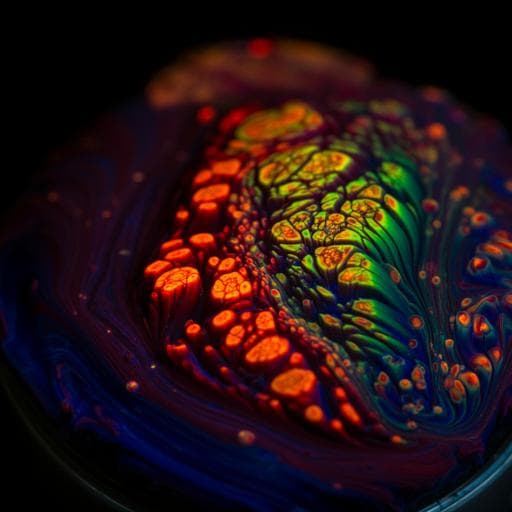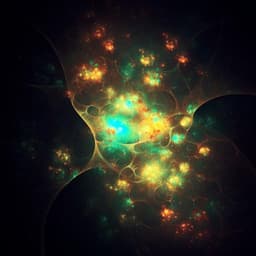
Chemistry
Color-tunable ultralong organic room temperature phosphorescence from a multicomponent copolymer
L. Gu, H. Wu, et al.
Discover groundbreaking research by Long Gu and colleagues that unveils a revolutionary strategy for achieving color-tunable ultralong organic room temperature phosphorescence in polymers. This innovation enables these materials to emit a spectrum of colors, ideal for advanced applications like multilevel information encryption and bio-labels.
~3 min • Beginner • English
Introduction
Room-temperature phosphorescence (RTP) with ultralong lifetimes enables applications from displays and anti-counterfeiting to bio-related uses, but has historically been dominated by inorganic materials due to limited intersystem crossing (ISC) and strong non-radiative decay in organics. Metal-free organic approaches have improved UOP via strategies such as crystal engineering, host–guest doping, MOFs, H-aggregation, and other methods that enhance ISC and suppress triplet deactivation. Crystal-based UOP, however, suffers from reproducibility, processability, and flexibility issues, motivating polymeric RTP systems. While polymer matrices have achieved longer UOP lifetimes through rigidification (homopolymerization, binary copolymerization, embedding small molecules), achieving excitation-dependent color-tunable UOP within a single polymer under ambient conditions remained unreported. The study aims to realize excitation-wavelength-responsive, color-tunable UOP in polymers by integrating multiple UOP-emitting centers into a cross-linked polymer network that provides a rigid, hydrogen-bonded microenvironment for long-lived RTP at room temperature.
Literature Review
Prior work established that rigid environments promote UOP in organics through crystal engineering, host–guest systems, MOFs, H-aggregation, and molecular design that enhances ISC and suppresses non-radiative decay. However, crystal-based systems face challenges in reproducibility, processability, and flexibility. Polymeric matrices have been explored to stabilize triplets and extend lifetimes by homopolymerization, binary copolymerization, or embedding small molecules into rigid polymers, achieving ultralong RTP in amorphous states. Despite advances in multicolor fluorescence via compositional and packing control, color-tunable RTP within a single polymer in ambient conditions had not been demonstrated, highlighting the unmet need addressed here.
Methodology
Design: Multicomponent copolymers were created via radical cross-linked copolymerization of acrylic acid (AA) with multiple vinyl/allyl-functionalized luminophores to install distinct RTP centers on a PAA backbone while forming a rigid, hydrogen-bonded network to suppress non-radiative decay.
Key materials: Monomers included diallyl phthalate (MDP), di(but-3-en-1-yl) naphthalene-2,6-dicarboxylate (MND), and di(but-3-en-1-yl) (1,1'-biphenyl)-4,4'-dicarboxylate (MBD). Monomers were synthesized via EDCI/DMAP-mediated esterification in DMF followed by purification by column chromatography; NMR confirmed structures.
Polymer synthesis: Radical copolymerizations employed AIBN initiator in dry toluene under nitrogen at 70 °C for 17 h. Products were isolated, washed, dialyzed (MWCO 2000) for 72 h, then cast and thermally treated at 100 °C to obtain transparent films.
- PDNA: Copolymer of AA with MDP and MND (typical feed MND/MDP/AA = 1/200/10,000; also series PDNA-5, -10, -20, -40, -100 with MND:MDP:AA of 1:5:1000 to 1:100:1000). Example charges: MND 0.0013 g (0.0041 mmol), MDP 0.2 g (0.82 mmol), AA 2.95 g (41.0 mmol), AIBN 0.008 g, toluene 75 mL. PDNA had Mn ≈ 67.3 kDa.
- PDA, PNA, PBA: Binary copolymers of AA with MDP, MND, and MBD, respectively, under similar conditions.
- PDBA: Multicomponent copolymer of AA with MDP and MBD; example feed MBD:MDP:AA = 1:5:1000.
Characterization and measurements: NMR for monomer verification; photophysical characterization on polymer films at room temperature: excitation–phosphorescence mapping (≈200–420 nm excitation range), time-resolved emission spectra, CIE coordinate analysis. Lifetime measurements at key emission wavelengths (e.g., PDNA at 445 and 517 nm; PDBA at 447 and 514 nm). Humidity effects were probed by exposing films to ~86% RH and monitoring lifetime decay over time. Controls included physical embedding of MDP and MND into PAA to contrast with covalent cross-linking. WAXS/powder XRD probed amorphous structure. Quantum yields and theoretical calculations (NTOs, T1 energies) supported mechanism analysis. Application demo: Ink patterning with polymer solutions (e.g., PDNA and PDA), drying at 75 °C, UV excitation at 254 and 365 nm, and water spray for erasability.
Key Findings
- Achieved excitation-wavelength-dependent, color-tunable ultralong organic phosphorescence (UOP) in single polymers under ambient conditions by integrating multiple luminophores into a cross-linked PAA network.
- PDNA (AA + MDP + MND): As excitation increases from ~254 to 370 nm, emission shifts from blue to yellow with phosphorescence bands moving from ≈445 nm to ≈547 nm; corresponding long-lived afterglow visibly lasts ~4 s (254 nm) and ~9 s (365 nm).
- Quantitative performance: Maximum phosphorescence lifetime up to ~1.2 s and maximum phosphorescence quantum yield of 37.5% (ambient conditions). PDNA Mn ≈ 67.3 kDa.
- CIE coordinates vary linearly from blue to yellow as excitation changes (270–370 nm), indicating controlled color tunability.
- Mechanism: Ratiometric modulation of two phosphorescent centers—blue emission from MDP (~445 nm) and yellow from MND (~517–547 nm)—via excitation-dependent population; supported by excitation spectra, monomer low-temperature phosphorescence, binary polymer references (PDA, PNA), and calculations (T1 of MDP ~362 nm; MND ~498 nm in gas phase).
- Structural features: Cross-linked, hydrogen-bonded PAA matrix forms a rigid microenvironment that enhances ISC, restricts molecular motion, and protects triplets from quenching (oxygen, moisture); PDNA is amorphous (broad WAXS/XRD features ~17° and 36°).
- Humidity sensitivity: At 86% RH, lifetimes at 445 and 517 nm decrease significantly within 60 min due to hydrogen-bond disruption, confirming matrix rigidity is essential; effect reversible upon drying.
- Control: Physical embedding of MDP and MND into PAA yields weak, short-lived phosphorescence, underscoring the necessity of covalent cross-linking.
- Generality: Second multicomponent copolymer PDBA (AA + MDP + MBD) shows excitation-dependent shift from ~445 to ~514 nm with lifetimes of ~578 ms (447 nm) and ~609 ms (514 nm), demonstrating broader applicability.
- Application: Multilevel information encryption demonstrated using PDNA and PDA inks. Under 254 nm UV, both exhibit similar blue emission; afterglow shows false message (“RNTUP”). Under 365 nm UV, afterglow reveals true message (“NTU”) in yellow; water spray erases afterglow by quenching RTP, with recoverability after drying.
Discussion
The study addresses the challenge of realizing excitation-dependent, color-tunable RTP in a single polymer matrix under ambient conditions. By covalently incorporating multiple phosphorescent centers (with distinct triplet energies) into a cross-linked, hydrogen-bonded PAA network, the emission color can be continuously tuned through the excitation wavelength, arising from ratiometric changes in the relative phosphorescence intensities of the different luminophores. The rigid microenvironment promotes ISC and suppresses non-radiative decay, enabling long lifetimes and high quantum yields while maintaining the amorphous, processable nature of polymers. The demonstration of multilevel information encryption underscores the functional relevance. Compared to crystal-based UOP, these polymers offer improved processability, flexibility, and reproducibility, while achieving long-lived, tunable afterglow at room temperature. The humidity-dependent quenching further corroborates the role of hydrogen-bonded rigidity, and the failure of physical mixtures highlights the importance of covalent network design.
Conclusion
This work introduces a general polymer design strategy—multicomponent radical cross-linked copolymerization—to achieve excitation-wavelength-responsive, color-tunable ultralong RTP at room temperature. The copolymers exhibit tunable afterglow from blue (≈445 nm) to yellow (≈547 nm) with lifetimes up to ~1.2 s and quantum yields up to 37.5% in air. The color tunability originates from ratiometric control of multiple triplet emitters within a rigid, hydrogen-bonded polymer network that stabilizes triplets and limits non-radiative decay. The approach is generalizable (validated with PDNA and PDBA) and enables practical functions such as multilevel information encryption with erasability and reusability. These findings provide guidelines for developing multicolor bio-labels, smart luminescent materials, multicolor displays, and secure data storage based on organic RTP polymers.
Limitations
- Moisture sensitivity: High humidity (~86% RH) disrupts hydrogen bonding in the polymer network, significantly reducing RTP lifetimes within 60 minutes; oxygen and moisture remain quenchers of triplet excitons.
- Requirement for covalent cross-linking and rigid hydrogen-bonded matrices: Physical embedding of luminophores in PAA gives weak and short-lived phosphorescence, indicating that network formation is essential.
- Excitation reliance: Color tuning demonstrated primarily under UV excitation (≈254–370 nm), which may limit some application contexts without UV sources.
Related Publications
Explore these studies to deepen your understanding of the subject.







